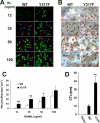Syk tyrosine 317 negatively regulates osteoclast function via the ubiquitin-protein isopeptide ligase activity of Cbl
- PMID: 19419964
- PMCID: PMC2707246
- DOI: 10.1074/jbc.M109.012385
Syk tyrosine 317 negatively regulates osteoclast function via the ubiquitin-protein isopeptide ligase activity of Cbl
Abstract
Cytoskeletal organization of the osteoclast (OC), which is central to the capacity of the cell to resorb bone, is induced by occupancy of the alphavbeta3 integrin or the macrophage colony-stimulating factor (M-CSF) receptor c-Fms. In both circumstances, the tyrosine kinase Syk is an essential signaling intermediary. We demonstrate that Cbl negatively regulates OC function by interacting with Syk(Y317). Expression of nonphosphorylatable Syk(Y317F) in primary Syk(-/-) OCs enhances M-CSF- and alphavbeta3-induced phosphorylation of the cytoskeleton-organizing molecules, SLP76, Vav3, and PLCgamma2, to levels greater than wild type, thereby accelerating the resorptive capacity of the cell. Syk(Y317) suppresses cytoskeletal organization and function while binding the ubiquitin-protein isopeptide ligase Cbl. Consequently, Syk(Y317F) abolishes M-CSF- and integrin-stimulated Syk ubiquitination. Thus, Cbl/Syk(Y317) association negatively regulates OC function and therefore is essential for maintenance of skeletal homeostasis.
Figures






References
Publication types
MeSH terms
Substances
Grants and funding
LinkOut - more resources
Full Text Sources
Other Literature Sources
Research Materials
Miscellaneous

